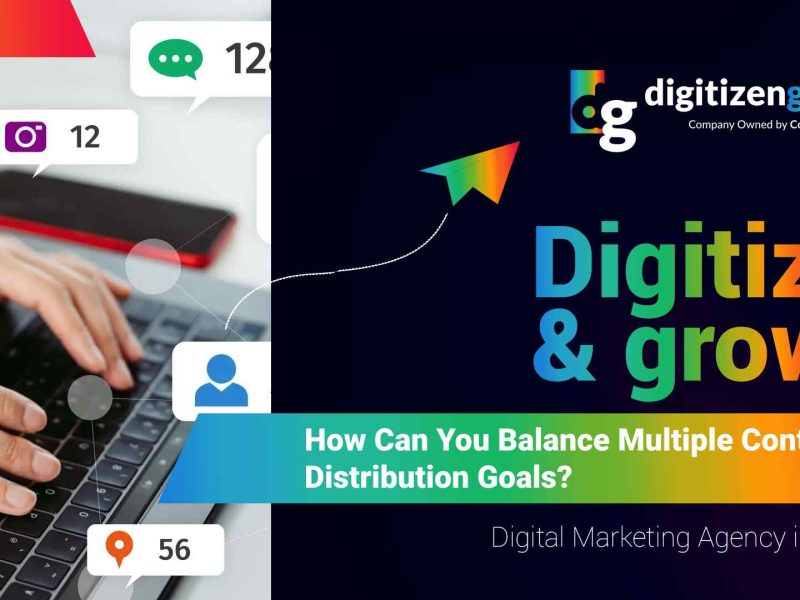Having a solid strategy for content distribution can mean a big difference when it comes to how your business reaches its audience. For this reason, it is important to define your goals and steps for achieving success in this area.
In this article, you are going to learn how to balance your content distribution goals as well as how to develop a solid plan for boosting your brand.
What Is Content Distribution?
As its name implies, content distribution refers to the content you publish, promote, or share across your different channels. Thus, it aims to extend your reach so you expand to a bigger audience.
Therefore, you should aim to make valuable content that provides interesting insights to your desired customers. This way, you will be becoming a tool for them, and they will be interested in purchasing your products or acquiring your services.
However, it is not as easy as it may seem, as you should know how to develop a strategy that allows you to share your content efficiently to obtain great results.
The following are the benefits of having a solid strategy for your content distribution:
- Driving more traffic to your business website
- Increase engagement with your content
- Build brand awareness
- Develop trust between your business and your audience
- Generate more leads that will translate into conversions
- Improve your ranking and search visibility
Types Of Content Distribution
There are several types of content distribution channels that you can use to spread the word about your business. Generally, these channels can be divided into the following:
- Paid
- Earned
- Owned
1. Owned channels
Owned channels, also known as owned media, are the ones owned by your brand, thus they are free. Therefore, in these channels, you can publish whatever you want without having to pay anything.
The following are examples of owned media:
- Social media: Facebook, LinkedIn, Twitter, Instagram, etc.
- Website: content you share in your blog posts
- Email marketing
- Offline media: retail stores, brochures, etc.
As you can see, your owned media is a powerful tool when it comes to your strategy, as you control it. In a nutshell, you should use it as a tool to reach your audience organically.
In this regard, you have to follow successful social media marketing tips for your owned channels.
2. Earned Channels
Earned channels are those where others are talking about your business, for example, when an influencer is promoting your brand’s products and services.
Some of the earned channels a business has access to are the following:
- Influencers
- PR
- Reviews of products or services
- Advocates and fans who share your content
- Viral posts
- Bloggers
Even though having access to earned media also requires investment, it is not the same as paid channels. This is because they work on recommending your brand by instilling customer trust through advocacy.
Therefore, you have to look for partners and customer advocates who can start different forms of conversations both online and offline to boost your brand.
When it comes to earned channels, it is important to learn about the difference between marketing and advertising. Thus, you can take the most out of your investment.
3. Paid Channels
Paid channels are simply those where you need to invest to reach conversions or get visitors, such as the following:
- Traditional advertising: print media, radio, billboards, and TV ads.
- Ads on social media
- Ads on Search Engine results
- Affiliate marketing
- Ads displayed on websites
One of the advantages of paid media is that you get access to advanced targeting options. Thus, you can reach your desired audience by just establishing it.
Lastly, do not overestimate the power of additional channels, for example, you can take advantage of how local marketing makes your business shine.
Content Distribution Channels
There are several content distribution channels available to reach your target audience. Below are a few of the most famous channels such as
- Facebook Marketing
- Twitter Marketing
- LinkedIn Marketing
- Instagram Marketing
- Email marketing
- Video Marketing
- TikTok Marketing
What Is Content Distribution Strategy?
A content distribution strategy involves considering what content you will share, where you will share it, and how you will share it, to achieve your goals.
Therefore, you have to coordinate your content considering all the types of distribution channels and the appropriate time.
But, how can you refine your content distribution strategy? You should make sure you consider the following first:
- Target audience: who is the audience you would like to reach?
- Buyer persona: who is your ideal customer?
- Content formats: what type of content is more attractive for your audience?
- Platforms and channels: where do you think your audience is or spends more time?
- Publishing schedule: how frequently do you have to share content?
- Track performance: how will you measure how your content is performing?
As you can see, developing your strategy involves taking into account several aspects. Thus, you cannot overlook any of them or your strategy will be incomplete.
How Can You Polish Your Content Distribution Strategy?
It may be the case that you have already developed a strategy for your content distribution. However, if you are not getting leads or perhaps you are even getting less traffic, then that means that your strategy is not working properly.
Thus, you have to refine it to boost your results. How can you polish your content distribution strategy? There are many steps you can take, such as the following:
- Check your content: perhaps the quality of your content is not great. Check that videos have high resolution, images are well designed, and that the information is exactly what your audience is looking for.
- Identify your audience’s preferred channels: if your content is awesome, then it is probably not reaching your audience. Perhaps you are publishing it on Instagram but your customer base is on Twitter. So, check which channels are more popular for your buyer persona.
- Monitor trends: maybe your content is not updated or does not appeal to your audience. In this case, check trends to update your brand.
Lastly, to refine your strategy you should also follow the tips for building effective social media advertising.
How Do You Create An Effective Content Distribution Strategy?
If you are now considering developing a strategy for content distribution, then you have to go through several steps. By following key recommendations, you will be designing a robust distribution plan for the content you will share.
The following are the advantages of developing your strategy:
- Creating and sharing content with a strategic approach instead of randomly
- Increase your reach
- Encourage loyalty within your customer base
- More interactions that lead to engagement
1. Know your audience
Your audience is who will consume your content; therefore, your strategy begins with it. Research the following about your audience:
- Demographics
- Interests
- Preferred content formats
- Challenges they encounter
- Platforms where they are active
Although it may seem simple, you have to know how to get insights about your buyers. To do this, you have to define your buyer persona first.
After that, carry out extensive research such as surveys or interviews. Next, analyze your traffic data and analytics of your social media and website. With this, you can develop your segment.
2. Set SMART goals
Now that you know your audience, your next move should be to define your goals. What is the goal you have with your content? Is it more traffic, engagement, leads, or something else?
In this regard, you should define goals that are according to the SMART method. Therefore, they should comply with the following:
- Specific
- Measurable
- Achievable
- Relevant
- Time-bound
3. Choose your content types
How do you create an effective content distribution strategy? You have to define what type of content is more attractive to your audience.
The following are some of the content types you can use:
- Long videos
- Tutorials
- Unboxing videos
- Reels
- Product photographs
- Reviews
- Contests
- Testimonials
- Infographics
As you can see, there are many options. Therefore, you have to know your audience by analyzing with which content they engage.
4. Identify your distribution channels
Which channels are you going to use for your content distribution strategy? As you know, there are several types, and even though it may be tempting to use them all, you have to redirect your efforts to platforms that will deliver better results.
How can you choose the channels to use? Consider the following:
- Your audience’s preferences
- Consumption habits of your customers
Thus, it is recommended to start with your owned channels first, to have a solid base. After that, you can consider paid channels to extend your reach. And lastly, look for influences that can promote your brand.
For example, if you identify that your audience is in a particular channel, you have to put your efforts into that one in particular. For instance, you could follow the Twitter marketing strategy for posting for peak engagement.
5. Develop a content calendar
Once you are inspired by your content distribution ideas, you have defined your type and formats, and chosen your channels, the next step is to develop a calendar.
You have to do this as this allows you to achieve consistency and ensure your audience sees you constantly. The following are some of the benefits of a content calendar:
- Keeps you organized
- Ensures you are on track
- Keeps your customer base engaged
- Reduces stress on your daily posting
- Helps you be prepared for special occasions or holidays where your brand can stand out
Strategies For Balancing Multiple Content Distribution Goals
Even though you have a solid content distribution strategy, it may be difficult to balance all of your goals across your channels. For this reason, you need to follow some crucial steps that will provide the following benefits:
- Balance your efforts to enhance your results
- Your content may go viral
- Use popular channels to increase your brand awareness
- Flexible approach
1. Prioritize and segment
How can you balance multiple content distribution goals? First of all, you need to prioritize sharing your content in the channels that have been proven to be more effective for your business.
Go through the following recommendations:
- Dedicate more time to channels that have a high ROI
- Share more content on platforms that align with your objectives
- Ensure you use channels that provide quality traffic
- Use analytics to segment your channels into those that are more effective
2. Leverage content repurposing
Content repurposing is a way to readapt what you share on your channels to adapt to ongoing and emerging trends and needs. Here we have the following recommendations:
- Prepare a single content and adapt it accordingly to various formats across your platforms
- Magnify your content value and reach by auditing your existing content and reevaluating it
- Look for posting also evergreen content that is still relevant after some other publications
- Maintain relevance and quality in all of your posts.
- Add fresh insights to your content
3. Schedule strategically
Even though you already have a calendar for content distribution, you need to know how to schedule your posts strategically. Do the following:
- Schedule your content for the hours when your audience is more active
- Distribute content evenly
- Avoid inconsistent timelines
- Coordinate content production across your channels
4. Measure and adapt
Check your analytics constantly, as this allows you to measure your impact and adapt your strategy on the go. Follow the next recommendations:
- Review your schedule regularly
- Assess your content performance and engagement
- Make data-driven decisions
- Learn about content metrics such as conversion rates, time on site, shares, lead generation, and more.
5. Embrace automation
Use tools that will make your content publishing easier. Currently, there are many software and service providers that will help you automate your distribution, such as the following:
- Schedule posts in bulk
- Use tools to create high-quality content with minimum effort
- Email marketing tools to send content to your subscribers automatically
- SEO tools to improve your content
- Tools to evaluate your competitors and identify opportunities
Since digitizing your business is the key to sustainable success, you have to also consider automation for your content distribution.
Start Your Content Distribution With DigitizenGrow
DigitizenGrow is a top digital marketing agency in Dubai and by following all of these recommendations, you can enhance your strategy for content distribution. Nonetheless, if you want to get even better results, then you have to contact us to ensure your success.









